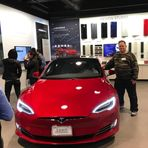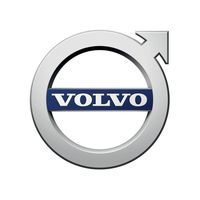The Electric Highway: GM's New Road to Tesla's Supercharger Network
September 20, 2024, 6:46 am

Location: United States, Texas, Austin
Employees: 10001+
Founded date: 2003
Total raised: $3.86B
The electric vehicle (EV) landscape is shifting. General Motors (GM) has made a significant move by allowing its electric cars access to Tesla's Supercharger network. This partnership is a game-changer, but it comes with a catch. Owners of Chevy, Cadillac, and GMC EVs will need to purchase a $225 adapter to plug into Tesla's charging stations.
This announcement follows a 15-month wait since GM and Tesla struck a deal. The initial plan was to synchronize software by spring 2024. However, delays arose from staffing changes within Tesla's Supercharger division.
Tesla has been busy. Before GM, it partnered with Ford, Rivian, Nissan, Volvo, Polestar, and Mercedes-Benz. Ford was quick off the mark, enabling its EVs to use Tesla's charging network as early as spring.
Now, GM's customers can access a staggering 17,800 Tesla charging stations. But there’s a twist. GM plans to source NACS adapters from multiple suppliers, not just Tesla. This is a smart move, given Tesla's slow production rate at its Buffalo, New York, factory. Other companies like Lectron and Qmerit are also in the adapter game.
In the coming years, new EV models will come equipped with built-in NACS ports. This means no more adapters. Just plug in and charge.
However, GM is not offering a free adapter period like Ford and Rivian did. Customers will need to pay upfront. This could rub some owners the wrong way.
GM is also enhancing its apps. Soon, drivers will be able to locate Tesla charging stations, check their status, approve charging, and make payments—all from their phones. But here’s the kicker: non-Tesla EV owners will pay slightly more for charging at Supercharger stations compared to Tesla drivers.
In 2022, GM announced plans to build its own charging network in the U.S. in collaboration with Pilot Company and EVGo. This project involves a consortium of seven companies forming a joint venture called Ionna.
As the electric vehicle market expands, partnerships like this are crucial. They create a more interconnected charging infrastructure. This is vital for the future of EVs.
But what does this mean for the average driver? Convenience is key. Access to a larger network of charging stations makes owning an EV more appealing. However, the cost of adapters could deter some potential buyers.
The EV market is a race. Companies are vying for dominance. Tesla has set the pace, but GM is now in the mix. This partnership could redefine the landscape.
Yet, challenges remain. The need for charging infrastructure is growing. As more people switch to electric, the demand for charging stations will skyrocket. Companies must keep up.
Meanwhile, a recent study by the Insurance Institute for Highway Safety (IIHS) raises concerns about driver behavior with partial automation systems. The research indicates that drivers are more likely to engage in distractions, like checking their phones or eating, when using systems like Tesla's Autopilot and Volvo's Pilot Assist.
This is a troubling trend. As technology advances, so do the risks. Drivers may feel a false sense of security. They might think they can relax, but that’s a dangerous mindset.
The IIHS study observed driver behavior over a month. It found that as drivers became accustomed to automation, their attention waned. This could lead to accidents.
The balance between technology and safety is delicate. Manufacturers must prioritize driver awareness. They need to ensure that automation aids, rather than replaces, human vigilance.
As the electric vehicle market evolves, so do the challenges. GM's access to Tesla's Supercharger network is a step forward. It opens doors for EV owners. But the cost of adapters and the potential for distracted driving are hurdles that need addressing.
The future of transportation is electric. It’s a thrilling ride, but it requires responsibility. As we embrace new technologies, we must also remain vigilant. The road ahead is bright, but it demands our attention.
In conclusion, GM's partnership with Tesla is a pivotal moment in the EV revolution. It signifies a shift towards greater accessibility and convenience for electric vehicle owners. However, the associated costs and the risks of distracted driving cannot be overlooked. The journey is just beginning, and it will take careful navigation to reach the destination safely.
This announcement follows a 15-month wait since GM and Tesla struck a deal. The initial plan was to synchronize software by spring 2024. However, delays arose from staffing changes within Tesla's Supercharger division.
Tesla has been busy. Before GM, it partnered with Ford, Rivian, Nissan, Volvo, Polestar, and Mercedes-Benz. Ford was quick off the mark, enabling its EVs to use Tesla's charging network as early as spring.
Now, GM's customers can access a staggering 17,800 Tesla charging stations. But there’s a twist. GM plans to source NACS adapters from multiple suppliers, not just Tesla. This is a smart move, given Tesla's slow production rate at its Buffalo, New York, factory. Other companies like Lectron and Qmerit are also in the adapter game.
In the coming years, new EV models will come equipped with built-in NACS ports. This means no more adapters. Just plug in and charge.
However, GM is not offering a free adapter period like Ford and Rivian did. Customers will need to pay upfront. This could rub some owners the wrong way.
GM is also enhancing its apps. Soon, drivers will be able to locate Tesla charging stations, check their status, approve charging, and make payments—all from their phones. But here’s the kicker: non-Tesla EV owners will pay slightly more for charging at Supercharger stations compared to Tesla drivers.
In 2022, GM announced plans to build its own charging network in the U.S. in collaboration with Pilot Company and EVGo. This project involves a consortium of seven companies forming a joint venture called Ionna.
As the electric vehicle market expands, partnerships like this are crucial. They create a more interconnected charging infrastructure. This is vital for the future of EVs.
But what does this mean for the average driver? Convenience is key. Access to a larger network of charging stations makes owning an EV more appealing. However, the cost of adapters could deter some potential buyers.
The EV market is a race. Companies are vying for dominance. Tesla has set the pace, but GM is now in the mix. This partnership could redefine the landscape.
Yet, challenges remain. The need for charging infrastructure is growing. As more people switch to electric, the demand for charging stations will skyrocket. Companies must keep up.
Meanwhile, a recent study by the Insurance Institute for Highway Safety (IIHS) raises concerns about driver behavior with partial automation systems. The research indicates that drivers are more likely to engage in distractions, like checking their phones or eating, when using systems like Tesla's Autopilot and Volvo's Pilot Assist.
This is a troubling trend. As technology advances, so do the risks. Drivers may feel a false sense of security. They might think they can relax, but that’s a dangerous mindset.
The IIHS study observed driver behavior over a month. It found that as drivers became accustomed to automation, their attention waned. This could lead to accidents.
The balance between technology and safety is delicate. Manufacturers must prioritize driver awareness. They need to ensure that automation aids, rather than replaces, human vigilance.
As the electric vehicle market evolves, so do the challenges. GM's access to Tesla's Supercharger network is a step forward. It opens doors for EV owners. But the cost of adapters and the potential for distracted driving are hurdles that need addressing.
The future of transportation is electric. It’s a thrilling ride, but it requires responsibility. As we embrace new technologies, we must also remain vigilant. The road ahead is bright, but it demands our attention.
In conclusion, GM's partnership with Tesla is a pivotal moment in the EV revolution. It signifies a shift towards greater accessibility and convenience for electric vehicle owners. However, the associated costs and the risks of distracted driving cannot be overlooked. The journey is just beginning, and it will take careful navigation to reach the destination safely.
